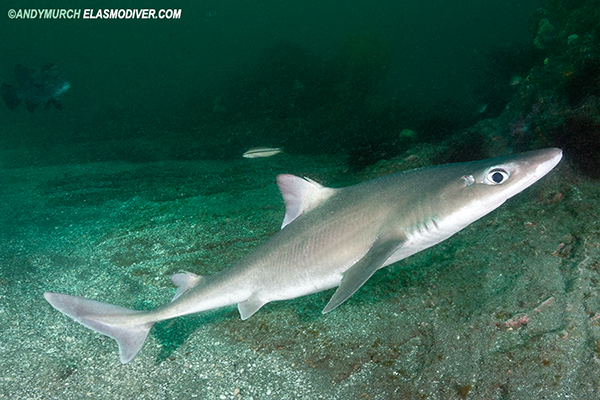|


View all available
Japanese Spurdog Pictures
in the Shark Picture Database
Common Names:
Japanese spurdog, Japanese
dogfish, spiny dogfish.
Binomial Name:
Squalus
japonicus
Family:
Squalidae
Identification:
A relatively
slender bodied dogfish with a long,
pointed snout. Small medial barbells on anterior nasal flaps. Body uniformly
reddish grey above with no spots.
Dorsal fins may be dusky towards apices. First dorsal high with
dusky margin. First dorsal fin spine about .5 x length of anterior
fin margin. Second dorsal fin smaller with a distinct notch on
trailing edge. Second dorsal fin spine about .75 x length of
anterior fin margin. Anal fin absent. Caudal fin and pectoral fins
have white trailing margins. Caudal may appear dusky in juveniles.
Caudal fins of neonates have a dark or black caudal notch. Belly white.
Size:
Maximum
length 95cm. Length at birth 19-30cm. Length at maturity - males 50-70cm,
females 56-80cm.
Habitat:
Continental shelf
from 52-400m.
Distribution:
The Japanese spurdog has a very limited range in the Northwest
Pacific Ocean. It is restricted to Japan, Korea and Taiwan. A long-snouted
form present in the Philippines has recently been described as a
separate species; the
Western longnosed spurdog Squalus nasutus.
Behavior:
Unknown.
Reproduction:
Ovoviviparous.
Litter size from 2-8.
Conservation Status:
Listed by the IUCN as 'Data
Deficient' but Japanese spurdogs are taken in fisheries off Japan,
Taiwan (Province of China) and probably elsewhere throughout their
range.There are no species-specific catch data available and the
species may be confused with other Squalus species. Squalus japonica
may have limiting life history characteristics, similar to other
deepwater dogfish, thus will not be sufficiently fecund to withstand
high levels of exploitation and there is concern, given that it is
apparently fished over large areas of its range. A lack of
information on the species population size, or any indicator of
population trend precludes an assessment beyond Data Deficient at
this time. Research is required to ascertain the importance of this
species to fisheries and bycatch levels.
Images: Tateyama,
Honshu, Japan.
Similar species:
The Japanese spurdog shares its range
with a number of other dogfish.
-
The shortspine
spurdog S.mitsukurii has a proportionately shorter nose,
a shorter first dorsal spine, more defined dark/dusky apices on each
dorsal, a less defined notch in the trailing edge of the second
dorsal fin and a dusky patch around the caudal notch.
-
The Japanese
shortnose spurdog S.brevirostris is a more robust species
with a much shorter snout.
-
The recently described Taiwan spurdog S.formosus has a
shorter snout and a higher, more upright first dorsal fin.
-
The North Pacific spiny dogfish S.suckleyi
has a shorter snout, an overall larger size and (usually) small
white spots on its back.
-
Blainville's dogfish S.blainville
Reaction to divers:
Rarely if ever encountered by divers.
Likely, this species would flee if approached by divers unless bait
is used.
Diving logistics:
The Japanese spurdog lives beyond recreational limits. The
shallowest records of this species are from Suruga Bay on the south
side of Honshu Island, Japan. Appropriately
trained technical divers may be able to bait this species in at
50m+. There are a number of dive shops on the Izu Peninsula that run
trips to dive sites in Suruga Bay.
References and citations:
Tanaka, S. &
McCormack, C. 2009. Squalus japonicus. The IUCN Red List of
Threatened Species 2009: e.T161433A5422974.
http://dx.doi.org/10.2305/IUCN.UK.2009-2.RLTS.T161433A5422974.en
|























